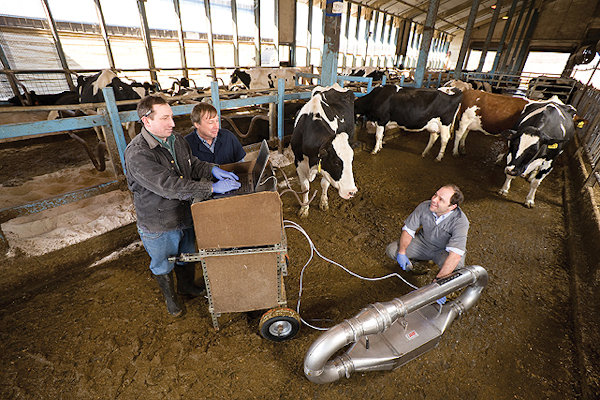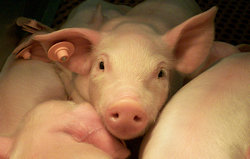SEJournal Online is the digital news magazine of the Society of Environmental Journalists. Learn more about SEJournal Online, including submission, subscription and advertising information.
 |
 |
| Agricultural researchers measure emissions from manure on a dairy barn floor. Manure pits at giant dairy and hog farms emit the greenhouse gas methane. They can also flood in heavy rains, spilling toxicants into nearby waterways. Photo: USDA/Stephen Ausmus. |
Feature: Six Ways To Cover the Environmental Impacts of Animal Agriculture
By Jenny Splitter
Second of two parts on food and climate. Read part one here.
Meat tends to be a divisive subject, especially in the United States.
Despite the headline-grabbing coverage of plant-based alternatives like faux burgers and lab-grown meat, most Americans remain regular meat eaters.
A Newsweek poll found 81% of those surveyed eat meat at least once a week and only a third were aware of meat’s environmental impact. The rest were either unsure whether eating less meat curbs climate emissions or did not believe that it does.
Environmental journalists who want
to tackle this topic have their work
cut out for them, but there are plenty
of angles for them to choose from.
Environmental journalists who want to tackle this topic have their work cut out for them, but there are plenty of angles for them to choose from.
Over the past 50 years, some things about animal agriculture have changed. Beef production has held steady while chicken production has increased fivefold, for instance. But regardless of the type of livestock, the vast majority (99%) of all meat produced in the United States comes from industrial-scale agricultural operations.
And that creates a whole host of environmental impacts — greenhouse gas emissions, water use, water and air pollution, deforestation, biodiversity loss and zoonotic disease transmission — not to mention animal welfare, public health and labor issues.
Not every story can touch on every impact, but being aware of the different ways animal agriculture affects the planet can deepen your reporting and inspire new story ideas.
From cornfield to meat counter and beyond
Whatever approach you take, the first thing to know is that the meat industry is massive — raking in $227.9 billion annually in the United States — and it’s made up of many moving parts.
These include acres and acres of farmland that grow feed crops (most of the soy and corn grown in the U.S. goes to animal feed, along with ethanol) and provide pasture for cattle and other grazing livestock animals (yes, even feedlot cattle spend part of their lives on pasture).
Industrial-scale factory farms and concentrated animal feeding operations, or CAFOs — facilities where animals are confined for feeding purposes and whose pollution is regulated by the U.S. Environmental Protection Agency — are also a significant part of the picture.
Although some farmers object to the
term ‘factory farm,’ its origin is none other
than the agriculture industry itself.
By the way, although some farmers object to the term “factory farm” and I avoided using it for years for that reason, I eventually changed my mind, because its origin (may require subscription) is none other than the agriculture industry itself.
Beyond the production side of things, the meat industry also includes slaughterhouses and facilities for processing and packaging.
And then there are the many other subindustries, from scientific companies that develop animal genetics for breeding to manufacturers that provide equipment and technology for farms and packing houses.
Not surprisingly, this massive industry has significant environmental impacts. Let’s take a look at them.
Burps and other emissions
Emissions from food and agriculture make up more than a quarter of all greenhouse gas emissions.
Within that sector or bucket of emissions, meat and dairy production are leading drivers, including emissions from the animals themselves, and from feed and land use. Meat and dairy farming is responsible for anywhere from 11% to 20% of all global greenhouse gas emissions, depending on which study you cite.
There are other greenhouse gas emissions sources too. For one, manure pits — mostly at giant dairy and hog farms — also emit methane.
Another example is nitrous oxide emissions, often driven by fertilizer use, both synthetic and all-natural forms from livestock.
And factory farms also release other toxic substances into the air. This pollution isn’t fueling climate change, but it has environmental health impacts for workers and nearby residents. Research from the Centers for Disease Control and Prevention has found higher rates of asthma and other health problems in communities located near these operations.
Intake and outflow
Industrial animal farms also wreak havoc on waterways, polluting them and draining them dry.
Runoff from farms is a leading cause of water pollution. Farmers sometimes apply too much synthetic fertilizer and manure to crops, which causes toxicants like nitrates and phosphorus to wash out of soils and into nearby waterways.
 |
| Pigs, above, are part of vaccine testing for zoonotic disease. Photo: USDA/Gloria Solano-Aguilar. |
Part of the problem is the massive amount of manure generated — 1.27 billion to 1.37 billion pounds of waste each year — and the way it’s stored. Manure is sometimes kept in pits that can flood in heavy rains.
Another important climate angle is the vast amounts of water used to raise cattle — more than 72 billion gallons of water per year, according to University of Nebraska researchers.
This has taken a particular toll in the drought-plagued western United States. According to a Nature study, 79% of Colorado River water goes to growing livestock feed crops, like alfalfa, corn and grain.
Deforestation, biodiversity loss, zoonotic diseases
Worldwide, a whopping 75% of deforestation is caused by agriculture, primarily the production of palm oil, soy (mostly for feed crops, not tofu) and beef (may require subscription).
While Amazon rainforest destruction receives massive amounts of media coverage, many other ecosystems are powerful tools for carbon sequestration and are threatened by agricultural expansion (typically for livestock farms or feed crops), including peatlands and grassy savannas.
The way we eat is leading to habitat loss for
tens of thousands of species and is a key threat
for 86% of all species at risk of extinction.
Agriculture-driven deforestation and the sheer number of farm animals around the world, as compared to wild animals, are also impacting biodiversity. Multiple studies have shown that the way we eat is leading to habitat loss for tens of thousands of species and is a key threat for 86% of all species at risk of extinction. Two trends to keep an eye on: ongoing avian flu outbreaks and swine flu.
There are public health threats for human communities too. Whether intensive or extensive agriculture, agroecology or industrial, cattle ranches or chicken barns, all types of animal agriculture drive zoonotic disease risk.
Our pandemic risk is now much higher than it was 10 years ago — five new pathogens per year on average instead of three — but some researchers have found that a shift to curb meat production and expansion of animal farming could help reduce that threat.
What about …? A note on solutions coverage
If you’re talking about the problems with industrial-scale animal agriculture, you might also want to offer up some solutions. But fixing the food system is a tall order, and no solution is perfect.
Some components are critical: Any alternative that holds itself out as a climate fix must tackle how much meat we eat.
You can also use the four pillars set out by the Solutions Journalism Network to ensure your reporting is rigorous. These require journalists to cover the evidence for how a solution works, or doesn’t, and also include its limitations.
[Editor’s Note: To go deeper on this topic, be sure to read part one of this two-parter, “Eat Local for Climate’s Sake? No, Eat Less Meat,” and check out our special Topic on the Beat pages on agriculture and the food system, which include a wide variety of stories from SEJournal, plus the latest food and ag headlines from EJToday.]
Jenny Splitter is an award-winning food and climate journalist for outlets such as The Guardian, Vox, Everyday Health, Undark, Popular Mechanics, The Washington Post and New York Magazine and the editor-in-chief of Sentient, a nonprofit news outlet covering factory farms and their impact on food, climate, health, policy and more.
* From the weekly news magazine SEJournal Online, Vol. 9, No. 11. Content from each new issue of SEJournal Online is available to the public via the SEJournal Online main page. Subscribe to the e-newsletter here. And see past issues of the SEJournal archived here.












 Advertisement
Advertisement 



